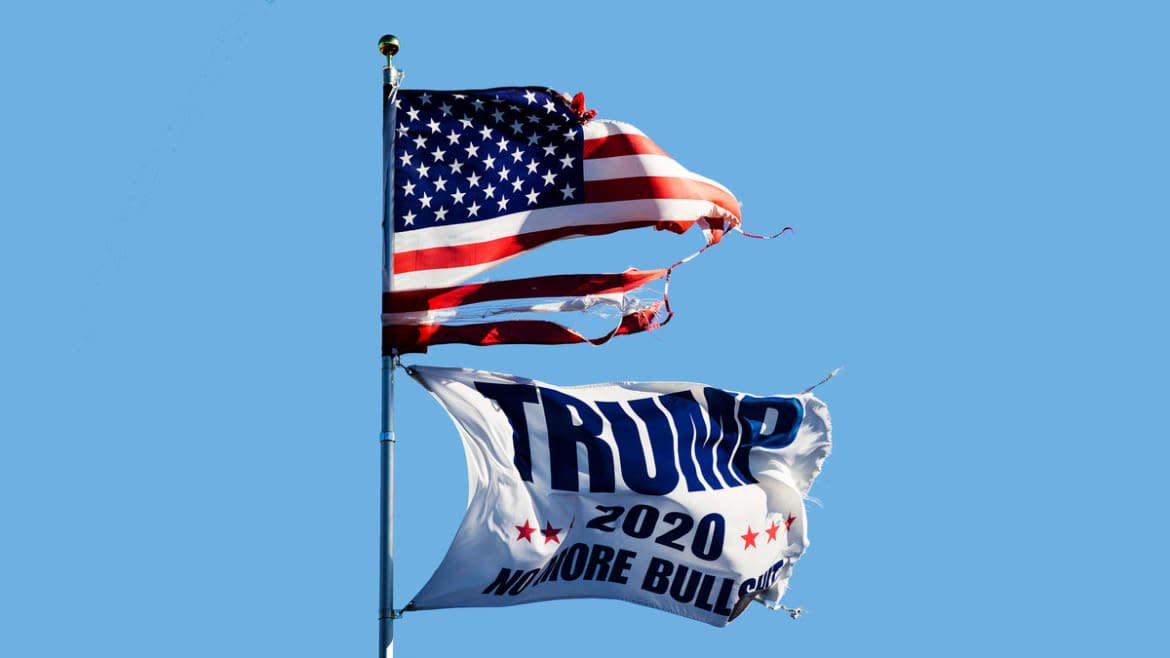Ugly Counterprotests Are Happening on Long Island for a Reason

Protesters on opposite sides of a police line shouted chants over each other. “Black lives matter,” one group shouted as it marched down a Merrick, New York, street.
“Go home,” the other group shouted back.
Long Island has long been regarded as one of the most racially segregated major metropolitan regions in the country. Merrick, an overwhelmingly white town bordering on two minority-white towns on the island, served as the poster child for that racial divide in a spate of recent coverage of segregation there. When some Merrick residents took to the streets on Tuesday, demanding racial justice after the killing of George Floyd in Minneapolis police custody, some of their neighbors accused them of not living there, telling them to go “three blocks” west—into a neighboring, majority-black town.
Although the dispute remained physically peaceful, the Long Island Press reported, angry shouts from a group opposed to Black Lives Matter protesters sent “Merrick” trending on social media on Wednesday.
The Tuesday incident, filmed on a street near Merrick’s border with neighboring Freeport, was one of the most visible gatherings of people demonstrating in opposition to the larger protest wave for racial justice in America. Police reform activists marched in the street while counter-protesters, some draped in American flags, shouted at them from the sidewalk. “Fuck you,” one sidewalk counter-protester was filmed shouting at the passing demonstrators.
Eventually the two groups came to a standoff outside a Dunkin’ Donuts, when police refused to let the march continue. “They’re not even from Nassau County,” one woman was filmed telling a police officer, referring to the area on the western side of Long Island, closer to New York City. “Send them home.”
“Check their licenses,” a man told a police officer in the same clip, later adding, “Let them go to Minneapolis.”
Protesters were, in fact, from the area. Two, interviewed by the Long Island Herald, were students at a nearby high school. But the suspicion—while consistent with a national trend toward claiming unrest is the product of violent outsiders—also reflected Long Island’s deep racial divides across town lines.
As Elaine Gross, president of the Long Island racial justice organization ERASE Racism, pointed out, backlash to Black Lives Matter protests “can happen anywhere.”
‘Let’s Keep Fighting’: Protesters Say New Charges Are Just a Start
That said, she noted, Long Island has a long history of segregation between towns. “That is not a new reality. It was planned that way, developed that way,” she told The Daily Beast, pointing to Levittown, a nearby town that enforced notoriously discriminatory housing practices barring people of color after World War II.
Although those measures have since lifted in name, Levittown, Merrick, and Rockville Centre were featured in a recent Newsday investigation about less obvious housing discrimination. In those three towns, realtors virtually never showed homes to people of color, the paper found.
The investigation noted that Merrick’s “western boundary, the Meadowbrook Parkway, sits like a barrier to two overwhelmingly minority communities, Roosevelt and Freeport.” That boundary, approximately three blocks west of the Tuesday protest, was the apparent reference in counter-protesters’ chants.
Further fueling Merrick residents’ suspicions was a flyer that spread widely across social media ahead of the protest, implying the demonstration would turn violent. “We will march East through white privileged neighborhoods towards Massapequa,” the image read, referencing another nearby town. “What is theirs is ours!”
The language was similar to that of other localized memes that incited panic with claims of impending Black Lives Matter agitation in white communities. Nassau County officials later warned social media hoaxes were falsely suggesting the protests would result in property damage.
Some other locales have reported aggrieved counter-protesters antagonizing Black Lives Matter marchers. In Philadelphia’s Fishtown neighborhood on Monday night, armed groups clashed with racial justice protesters and reportedly hospitalized a journalist, earning the condemnation of city officials. Some were reported to have high-fived and posed for pictures with police officers, whom they supported.
“If people want to come down and cause trouble, they’re not going to get far,” Nicholas Lucente, of South Philadelphia, told The Daily Beast at a counter-protest in that neighborhood on Monday. “It’s more or less a show of force.”
Though vocal—and in some cases dangling the prospect of violence—the backlash demonstrators appear to be in a minority. A national Monmouth University poll on Tuesday found that 57 percent of respondents agreed that the outcry over Floyd’s death was justified, with just 18 percent saying it was not justified at all.
And in Long Island and elsewhere, the protests are making first-time activists of many Americans, Gross noted.
“There are a lot of people who maybe even have not protested before who feel compelled and are very supportive of all peaceful demos that have taken place,” she said.
But, she added, referring to a Long Island restaurateur who called protesters “animals” this week in a viral video, there are some people “who'll have none of it.”
In other words, activists and communities of color in the area aren’t just contending with national trends toward police violence or racism. They’re fighting long legacies of housing discrimination and other systemic inequalities, just as Minneapolis residents have been. And in some cases, activists of color say, they’re also just dealing with present-day hate.
Or as Gross put it, of counter-protesters in Merrick, “As far as they’re concerned, they have no empathy whatsoever.”
With reporting by Sara Sheridan in Philadelphia
Got a tip? Send it to The Daily Beast here
Get our top stories in your inbox every day. Sign up now!
Daily Beast Membership: Beast Inside goes deeper on the stories that matter to you. Learn more.

 Yahoo News
Yahoo News 
